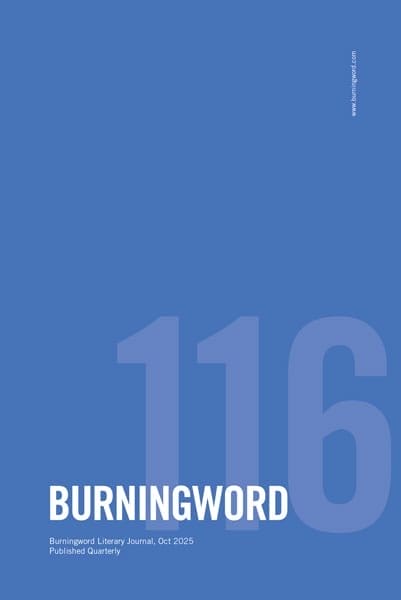July 2024 | poetry
Mural: St. Croix
A sailboat and its white hull floating on the water like a grimace or lopsided moon. How the banana daquiri’s implosions of flavor echoed on my tongue while the bartender stuffed a blender with five bananas for my 2nd. Tom and I. How our kayak-oars were conduits as we stuck them into waters aspark with bioluminescence. Squares of honey cake swelling with flavor. So many abandoned cars in the jungle and their decades of rust—a museum of automotive osteology. Eight fathoms down a wall of reef: the divemaster skewering a lionfish and the nurse shark’s path, vacillating maniacally like a soundwave, to claim it with his big-mouth snatch. How scuba collapsed the world I knew, like a theatre curtain dropping to reveal hallways of stages. Submerged parts of the pier’s pillars coated in reef—outgrowths of webbed rock and branches of staghorn coral grasping at schools that meander by. How most days people ask are you on your honeymoon and chuckling to each other, full of fourteen years. The blue of that ocean, impossible to recreate like something from a dream—as if blue were ethereal or majestic or supernatural—certainly not of this earth. A blue-I-couldn’t-believe and repeatedly blinked at, waiting for it to resemble a more familiar shade. 10 PM, in the kayak, falling back into Tom’s arms to stare upwards at a night that churned with sprays of stars, the ocean beneath us aswirl with glittering sediment, eager and alive.
Mural: Three years in Key West
Conchs everywhere but the beach. Bruise-blue crabs scuttling the estuary’s woods. The muse that is Key Lime Pie and each local chef’s interpretation realized in three-story displays of crust, tang, and fluff, peaked into mountain ranges burnt into the mallow. Mammoth iguanas straddling the prehistoric and domestic, clenching to branches of manicured bushes. A life-size cutout of Judy Blume. Frogs no bigger than croutons bounding on walkways, their translucent sacs of bodies pumping with tiny organelles. A high school with entirely outdoor passing periods. Our calicos discovering—reveling—in the back porch’s liminal space of sun and carpet. Plush algae affixed to boulders like thick, emerald embroidery on stonewash denim. Coy pelicans with that dreamy and bashful, blue-eyed gaze. My husband and I—how our love doesn’t abide entropy, gaining energy the longer we’re together. The sky ever-heaping in a stack of contrails as if a pile of bones on a blue x-ray. The massive, sapphire and yellow swimming heads of queen angel fish. Art galleries featuring kitsch-pop art full of unsubtle commentaries on an afflicted humanity. Colonial homes painted in egg-shell-varieties of blue or pink or yellow. That freakish amalgamation of stingray and crustacean realized in a scuttling horseshoe crab. A Hemingway cat’s fat-pawed grasp on my thigh, while sitting in the backyard of the writer’s famous mansion.
Courtney Hitson
Courtney Hitson holds an MFA in poetry from Columbia College Chicago and currently teaches English at the College of the Florida Keys. Her poems have appeared in numerous literary journals, including DMQ Review, Wisconsin Review, McNeese Review, and others. Courtney and her husband, Tom (also a poet), reside in Key West, Florida with their two cats.
July 2024 | poetry
Last Day of Magic
For example, when you take a funhouse
seriously, you’ll want mirrors to keep
the world inside the glass from falling out
like a labryinth into the future or the past
for all to see—the ceiling, the floor, the plywood
with splinters spliced into planks
that join the festival
moon with its halo of haze—
you’ll eventually want to stroll through
the mirrors and meet the clowns
unicycling along sawdust paths and juggling
seltzer bottles and bowling pins.
You’ll ask the coulrophobes, why not
dream of the funhouse
falling into a sideshow and a ring toss
and the never-ending carousel.
You’ll want to walk over to Water Street.
The Rotary Club will sell you a funnel cake.
Go ahead, try a mallet
at the Whac-A-Mole and walk
with the living folk into the haunted house
we keep filling up
even if we are a small town.
You’ll want to wait until 9 o’clock,
when fireworks blush the air over the canal works—
roman candles and parachutes, bengal lights and aerial shells
will rocket from the barge
sitting north of the locks.
Pretty soon the thought will strike you
halfway convinced that H.P. Lovecraft had lived here,
you’ll bet five bucks
he loved the cars idling under the bridge,
the winters when slush finally thawed
and earth gushed green and the canal
flowed and the young girls
with their melancholy eyes, opaque as the boredom
they wear like a prom dress,
filled the sidewalks
with bicycles and Segways. You’ll want to take
the path with the tourists
stepping back from skateboarders
crossing George Bailey Bridge,
where exactly 1,000 yellow ducks drop
into the algae-mottled canal
and you’ll want to gather with the rest of us
to cheer for the ducks racing
in what could be the world’s
slowest Derby or Preakness,
and you’ll remember it for a long time.
Myth and Fairytale
A friend once told me his wife
passed away without a mark— as if sleeping;
her body perfect, tranquil and slumped
as if telling a story
quietly to herself inside.
Before his wife died,
we already had ourselves
to see by candlelight in cold places,
where we were close enough
we often spoke.
I thought about that man
in the February of this year,
and his wife. Who’s to say I never
go back to the old stories
I thought I’d left behind.
The man whose wife died and I
spoke while driving
on an icy road going to church.
We found ourselves young enough once
to take in the comfort
of the snowy countryside.
Ours was a story that began
once upon a time. “Let’s go,” he said,
“let’s leave this cold February
and live our best life—
and he hung up the phone—
Bob Haynes
Bob Haynes lives in Seneca Falls, New York. His poems have appeared in North American Review, Nimrod, New Letters, Poetry Northwest, Rattle, Bellingham Review, Lake Effect, Poet Lore, Cimarron Review, Natural Bridge, Louisville Review, and Louisiana Literature, as well as featured on the Verse Daily website. Poems have also been reprinted in anthologies Cabin Fever (Word Words) and Kansas City Out Loud (BkMk Press), and in the poetry textbook Important Words (Boynton/Cook Heinemann). His latest book, The Grand Unified Theory (Kansas City: Paladin Contemporaries). He currently teaches online writing and visual rhetoric, and poetry workshops at Arizona State University.
July 2024 | poetry
Eagles changed their migration routes across Ukraine to avoid fighting and because their habitats were likely damaged or destroyed by war, say scientists. – BBC 22/5/2024
to pick an enemy is no easy matter.
there are no half-measures,
no fair-weather enemies.
your enemy will give birth to you all over again
with a promise to never disappoint you, never fail you.
to burrow inside you deeper than any love.
not so much an ill wind
as that other hand on the tiller.
friends can be false,
enemies cannot.
even eagles change course
to avoid the pas de deux of enemies torturing the earth,
the pitted earth where no mouse or rabbit runs,
where love is either one of two things
but never both at the same time:
we wing-less creatures of binary.
Justin Lowe
Justin Lowe lives in a house called “Doug” in the Blue Mountains west of Sydney, where, until recently, he edited the international poetry blog Bluepepper. His ninth collection, San Luis is due out through Puncher & Wattman in October of this year. He also has a novel doing the rounds of publishers and has also had poems set to music by bands such as The Whitlams and The Impossibles.


